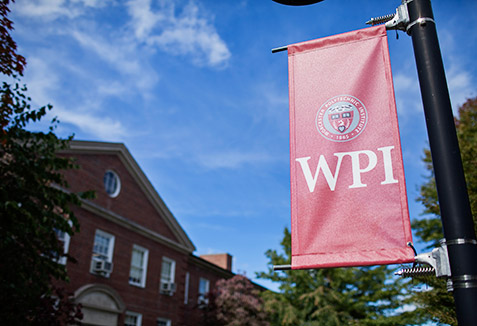
Worcester Polytechnic Institute’s (WPI) Team WPI-CMU—and its humanoid Atlas robot WARNER—placed in the top third of 24 teams at the international DARPA Robotics Challenge (DRC) held at the Fairplex in Pomona, California, June 5-6, 2015.
A six-foot-two humanoid Atlas robot, made by Boston Dynamics, WARNER (which stands for WPI’s Atlas Robot for Nonconventional Emergency Response) is the centerpiece of Team WPI-CMU, a robotics team made up of faculty, engineers, and students from WPI and Carnegie Mellon University (CMU). The team members have been working together since the summer of 2013, and qualified for this competition in December of that year, when they placed seventh in the DRC trials. Ultimately, 24 teams from around the globe competed in the DRC Finals, maneuvering highly specialized robots in eight autonomous and semi-autonomous mobility and manipulation tasks that demonstrated their ability to manage in uncontrolled and unpredictable situations, often without human direction. Team KAIST, of South Korea, was awarded first place and $2 million; Team IMHC Robotics of Pensacola, Florida, was second and received $1 million; and Tartan Rescue of CMU was third, taking home $500,000.
DARPA (Defense Advanced Research Projects Agency) is an agency of the U.S. Department of Defense and is responsible for the development of emerging technologies for use by the military. According to DARPA, technologies resulting from the Challenge “will transform the field of robotics and catapult forward development of robots featuring task-level autonomy that can operate in the hazardous, degraded conditions common in disaster zones.” The DRC was created after the nuclear disaster in Fukushima, Japan, in March 2011, which created an environment too hazardous for humans to enter.
“When DARPA issued this challenge, people had their doubts that any robot would be able to perform these extremely complex tasks at the finals,” said WPI President Laurie Leshin, who cheered the team on in Pomona. “However, for the past two and half years, we were watching Team WPI-CMU work towards this ambitious goal, and we could see something remarkable happening. We knew they would go to the DRC Finals ready to compete with the best in the field, and I’m so proud of all they’ve accomplished. I’m also genuinely pleased that the field of robotics has advanced this far, this fast. DARPA is to be commended for posing this challenge, and all 24 teams are to be commended for pouring themselves into it.”
This year, WARNER successfully completed seven of eight tasks on each day of the competition, which included driving a vehicle, opening a door, using power tools, and turning a valve. Teams had 60 minutes to complete the course and were awarded one point for each task for a potential total of eight points.
“The guiding principal for WPI Robotics faculty, researchers, and students is to apply our knowledge and skills to help create robotic technologies and solutions that will help human beings live better, safer lives,” said Michael Gennert, professor of computer science and director of WPI’s Robotics Engineering Program. “This competition really spoke to WPI's strengths. WPI has earned a reputation in robotics as a pioneering institution with a drive for producing excellent work, for the desire and ability to collaborate, and for facilitating technological solutions for human and societal need. The DRC Finals showcased WPI as a fixture in international-level robotics competitions, and I am proud of this team's outstanding work.”
WPI became the only university in the United States to offer bachelor’s, master’s, and doctoral degrees in robotics engineering when it launched a PhD program in 2010. WPI was also the first university to offer a bachelor’s degree program in robotics engineering; its master’s program began in 2009. Only two other universities in the United States offer a doctoral program in robotics engineering.
Following the DRC trials, DARPA increased the difficulty level of the finals, prohibiting robots from being connected to power cords or wired communications tethers. DARPA also changed the scope: of the 24 teams that competed in the DRC Finals, only 11—including Team WPI-CMU—originally qualified in the December 2013 trials. DARPA later expanded the challenge, and ultimately 14 teams hailing from the United States, Germany, Hong Kong, Italy, Japan, the People’s Republic of China, and South Korea competed.
“Competing in the DRC Finals has been a once-in-a-lifetime experience for everyone on this team, and has provided faculty and students the chance to collaborate with outstanding roboticists from around the world,” said Team WPI-CMU leader Matt DeDonato. “The road to this weekend’s culminating event has been filled with long hours and tough technical challenges, but it has also been filled with great experiences, epiphanies, and camaraderie. One particular point of pride for the team was that WARNER was one of the only robots that scored major points, but that didn’t fall and wasn’t reset. Altogether though, it has been a thrilling ride, and I’m extremely proud of this team.” “I think every person involved in this endeavor felt victorious each time a task was completed successfully, no matter whose robot completed it, and we shared each other’s frustration when a robot struggled,” said Taskin Padir, assistant professor of robotics engineering at WPI. “Ultimately, the real thrill this weekend has been in collectively meeting the challenge DARPA set out for us. Innovations in robotic technology developed through the competition have brought us closer to creating reliable, efficient humanoid robots that can help respond to man-made and natural disasters.”
For more information about the event, DARPA Robotics Challenge including a list of all competing teams and their results, go to www.darpa.mil/program/darpa-robotics-challenge.
For videos and other information about WARNER and Team WPI-CMU, follow WARNER's adventures on Twitter.
